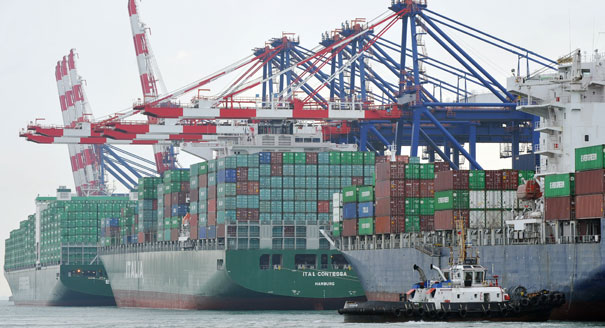China may have been the low-cost manufacturing center of the world for the past decade, exporting goods far and wide. But now a two-way exchange is on the rise. The ships leaving Asia for the United States no longer come back empty. BMW’s Spartanburg plant helps make that happen. The Spartanburg model could have significant implications for the global economy.
For BMW executives, the American city of Spartanburg, South Carolina, provides a low-cost manufacturing option. The German automaker manufactures 300,000 of its X-series sport-utility vehicles at this global plant and exports 70 percent of the plant’s annual production to over 130 countries.
China is not out of the loop. It is featured prominently in the picture—but as a buyer-importer this time instead of in its usual role as a seller-exporter. China is one of Spartanburg’s top export markets. As many as 20 percent of the X-series vehicles made at the plant went to China in 2012, generating export sales of more than $2 billion for BMW.
BMW’s model has shown that reasonably priced, highly standardized quality products can be manufactured in the West and exported to the rest of the world. It points to an undercurrent of globalization that is rippling in a new direction. While homegrown Chinese contract manufacturers have long been delivering basic goods cost-effectively to middle-class American customers, companies in high-income countries now profitably sell premium products to the nouveau riche in low-income countries.
Successful factory owners in China are known for showing off their wealth by driving oversized Lincoln imports around villages. It makes one wonder how many of the 60,000 or more BMW X-series sold into China are now in the hands of the owners of factories that have been shipping white picket fences, hydraulic cylinders, or Christmas decorations to the United States.
If the Spartanburg model can be extended to non-luxury products for a wider range of customers, the world may see two low-cost manufacturing centers in operation—one in China, delivering functional, labor-intensive products, and the other in the United States, responsible for sophisticated, capital-intensive products. Just as Chinese products penetrated the U.S. market, American-made products will leave their mark on rising standards of living in China. Businesses and governments may have to rethink their strategies and policies in light of the new postcrisis reality of globalization.
The economics of Spartanburg are intriguing. After all, exporting a complex, expensive piece of modern machinery in large quantities to a distant country as poor as China is a quite a feat. The state-of-the-art, highly automated Spartanburg plant takes as much as $6 billion of accumulated investment to build. The capable labor force is costly. Assembly workers earn $25 an hour plus benefits. Part suppliers are mostly from high-income countries.
But the product is standardized, however complex and customizable by design, making it possible to bring down average cost through mass production and keep the product price within reach for many customers. The U.S. dollar is cheap compared to the euro, justifying the location of the production site in the United States, and compared to the renminbi, boosting Chinese buyers’ purchasing power.
Finally, the insatiable appetite of the Chinese nouveau riche for status symbols completes the profitability equation for BMW. Product price is a non-issue when customers feel that the more expensive product is the better one. In fact, the dealer price in China for a BMW X3 is more than twice as high as the factory price in the United States.
Is the Spartanburg model widely applicable to non-luxury products so that more products made in the West can be profitably sold to developing countries? The question is worth asking because the globalized free market is expected to benefit those in need and to help raise the standard of living in low-income countries. Globalization will be judged as a failure if the market is only capable of conveying benefits to those who need help the least.
Indeed, in China, the standard of living for the majority of urban residents is as disturbingly low as the average income, which ranks 118th in the world. Supporters of the China model often choose to ignore this fundamental fact. Middle-income citizens labor tirelessly to reach a decent standard of living that the West achieved decades ago. But quality products essential for modern comfort remain out of reach for many of them. Imported products might be on the shelves, but the prices are prohibitively high, often 40 percent more expensive than in their home countries. It is no coincidence that Chinese exporters had enormous difficulty trying to sell U.S.-bound products to domestic Chinese customers after the 2008 financial crisis.
Western products are marketable in low-income countries like China when they fill big gaps and deliver major benefits, such that the premiums customers are willing to pay outweigh the higher costs. Given the underdeveloped and corrupt state of the domestic Chinese consumer product market, global products from the developed world are more appealing than ever. For Chinese parents who lost their faith in faulty local products, foreign brands of baby formula are their version of a BMW X3, and they are willing to pay a higher price for it. And for many Chinese consumers at least, once a product is made in China, its allure of authenticity and modernity disappears.
The Spartanburg model works when the product is highly standardized, the operation is superbly efficient, and the market is global. Consumers value the reliability and affordability found in products standardized for the world. Vast economies of scale and cost-effectiveness can only be attained by global companies that market more or less identical products to similar segments worldwide.
This is in contrast to the practices of both many Western multinational companies operating in China and Chinese manufacturers. Multinational companies may have originally intended to make products for both the Chinese market and the rest of the world. But many of them ended up either using China as the manufacturing base for solely supplying the Western market or only making local products for local customers. The anticipated global product never came to life. Similarly, Chinese exporting manufacturers take orders from distant Western customers, turning their backs on domestic demand. Their products are therefore not global either.
Without the economies of scale, profitability suffers, product quality deteriorates, and competitiveness falls. The pressure to switch to the more profitable Spartanburg model is mounting.
As middle-income citizens in less-developed countries strive to improve their living conditions and want to pay a premium for quality products, Western companies can profitably meet such demand by offering affordable, globally standardized products. The United States is poised to maintain its position as the leading global manufacturing center supplying sophisticated products not only to high-income countries but also to the less developed world. China’s competitiveness and its status as the factory of the world would be enhanced by developing truly global products.
National governments can facilitate this two-way exchange by providing an open and business-friendly environment for the development of affordable quality products for the world both in the United States and China. Withdrawing from the globalization process and retreating to one’s own national market is not an option. The success of the U.S. policy of bringing manufacturing home and increasing its exports depends on the willingness of other countries to keep their doors open.
There is no need for China to downplay exports and uphold domestic demand. If U.S.-based companies export large quantities to China, then China-based companies can continue to export to the United States without prompting a trade war. It is a step forward to acknowledge that the well-being of individual consumers is the ultimate goal of economic development. But the demand of many domestic consumers can also be met by global companies selling reasonably priced, world-standardized products from the West to China, as exemplified in the Spartanburg Model.
Shi Han is managing partner of ChinaLine, LLC
The Spartanburg Model and Beyond
China should embrace globalization and its own domestic market to become a truly global manufacturing power-house.
More work from Carnegie



- paperUkraine’s Regional Shift: Realignments in Wartime and Beyond
Regional disparities in investment, labor markets, and government transparency mean that regional development will be a key feature of Ukraine’s postwar future.
- Mariya Levonova,
- Balázs Jarábik
- paperFrom Caution to Competition: Positioning U.S. Development Finance for Industrial Power
The DFC remains constrained by slow and duplicative processes, narrow authorities, and a temporary authorization. A more ambitious vision could turn it into an expedient instrument of American power.
- articleIndonesia’s Fragile Middle Class
Indonesia’s strong macroeconomic outlook belies an anxiety among its aspiring middle class, evidenced by recent protests. This paper explores the roots of this paradox and offers policy avenues to improve economic opportunities for the aspiring middle class.
- researchArab Diaspora Business Communities in Egypt
Arab diaspora business communities in Egypt often mirror the same systemic challenges facing Egyptian businesses.

- +4
- Nur Arafeh,
- Yezid Sayigh,
- Qaboul al-Absi,
- Maya Chehade,
- Marie Bassi,
- Duaa Abuswar,
- Soraya Rahem




